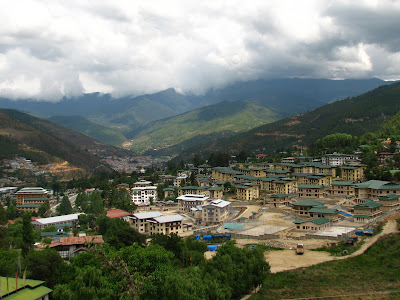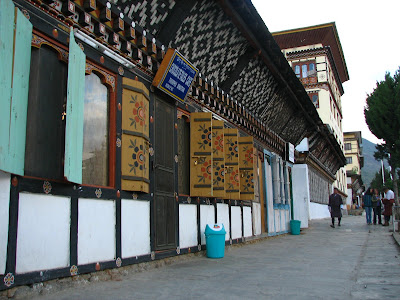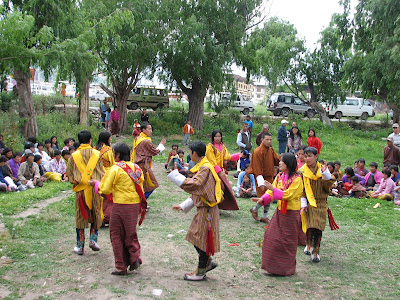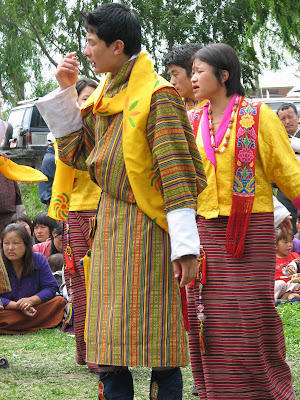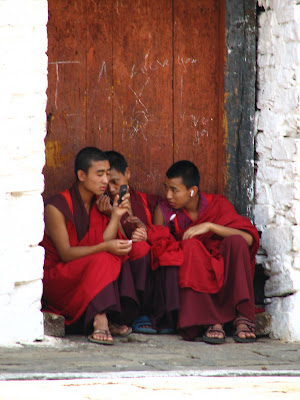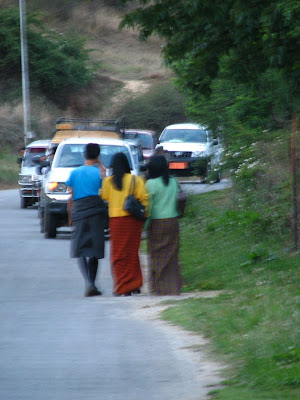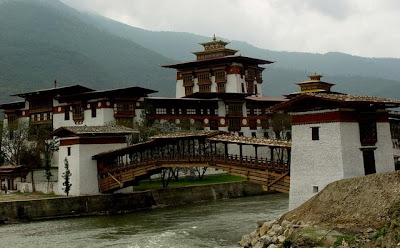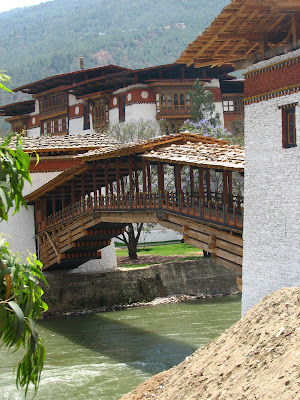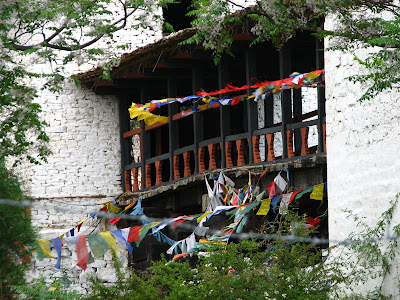
Now what can I say about a place where you can spend the morning in a 15th century Monastery perched on a hill-top over looking the confluence of two rivers and spend the night shaking a leg at a lively night club.
A so called ‘under-developed country’ where we only came across two beggars in nine days and SUV’s teemed the streets.
Where the King decides to abolish him and instate democracy in place of a century old Monarchy, but the people resist and let out a cry ‘we do not want democracy give us our King back’.
But then
Thimphu - the only capital in world with no traffic signals
Yes, its true, Thimphu is the only capital in the world with no traffic signals. Instead, they have police men with very fluid body movements (they honestly use their entire body) that direct traffic. In fact, at one point of time they did install traffic signals, but the citizens complained it was unsightly and impersonal and had them removed.
The City - The Architecture
We pulled into Thimphu in the middle of the night. My first impressions, in the dark were a) this city has a sense of space (well spread) b) the building although not huge, looked well planned and well built. Unlike most Indian Himalayan towns, Shimla, Mussoorie and Manali which are nestled in conifers but the buildings are an agglomerated mass of concrete sticking to one and other with no architectural cohesiveness.
Thimphu was very different and my initial impressions were not an illusion as I walked around the hotel the next morning. Thimphu does have a strictly enforced architectural code i.e. no building can be constructed over five stories and the roof of the buildings have to adhere to this particular gentle sloping style (as you shall see in the pictures). Since Thimphu, like all of Bhutan is nestled in the hills a short walk uphill and you would have an aerial view of the cityscape. The fact that all roofs are built in the same style, makes the view extremely pleasing to the eye. The city just blends into the mountains. It does not take away from the backdrops of the hills, in fact it my opinion it only adds to the landscape.
While Bhutan architecture does not seem to have alot of variety, you can still see visible traits of quintessential Bhutanese architecture in every building. Despite, some of them being as unimportant as a petrol station. You will still see the gentle sloping roof, some wall paintings of Bhutanese folklore. I loved the architectural cohesiveness that binds all buildings in Bhutan, even a stand alone building in the middle of the highway.
 The Clock Tower - A nice open place (Indian Ocean was in Concert here, 3 days before we got to Thimphu)
The Clock Tower - A nice open place (Indian Ocean was in Concert here, 3 days before we got to Thimphu)Center Street, Parallel Parking and Lovely Sidewalks
Simplistic, functional and elegant, three words that tend to aptly describe most things in Bhutan, except some Monasteries, they tend to be extravagant. Nonetheless, Thimphu center street is a fine example of the three adjectives.
All the hustle bustle, i.e. hotels, restaurants, shopping arcades, night clubs (5 of them and pretty lively), departmental stores and few important government offices that cater to tourist permits and other tourist needs are located on this street. Its a perfectly straight street, all buildings well spaced and in line, with a huge sidewalk lined with dustbins. Beyond which are yellow lines on the road for cars to park in a parallel formation.
I particularly enjoyed my walks along center street. For a bunch of reasons a) you'd get to observe the locals from different age groups, b) there was always this vibe on center street, excitement from shopping i guess and c) i just loved the sidewalk.
The 'Sidewalks' of Thimphu are very elegant. They stretch across the city and go all the way to the outskirts where there actually aren't any buildings at all. Lined with dim lampposts, it just underscores the point that most things are functional in Bhutan.
Sidewalk, is a chiefly North American term for Pavement (Wikipedia). I think Sidewalk just sounds better, and more because we did alot of walking on them.
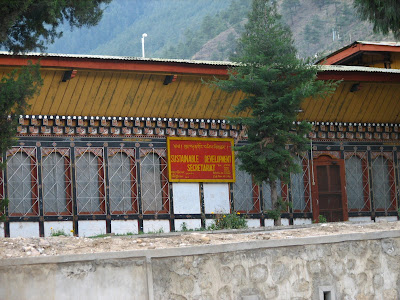 Everything is about Sustainable Development (50% of the Government Budget is financed by selling sustainable hydro-electricity to India)
Everything is about Sustainable Development (50% of the Government Budget is financed by selling sustainable hydro-electricity to India)Thimphu - About the City
Thimphu, (Pop 50,000) is quite a complete small town. In my opinion it has small town attributes of a 'developed country'. There was absolutely nothing displeasing about the town. The City is well planned and pretty, they have good public transport though its only 5 routes but they reach every corner of the town. It was spotlessly clean, they have a community 'Youth Center' complete with a public swimming pool and tennis courts. Night clubs, the Clock Tower Square for cultural events and a golf course. Cannot remember spotting a pothole on the roads or seeing any hawkers on the street either.
What initially really puzzled me about Thimphu was the over bearing presence of gleaming expensive SUV's. Unlike, India I hardly witnessed any beaten down vehicles. Something seemed amiss, people looked a little too rich for an under-developed country.
The following is what I alluded from conversations with various locals. Bhutan has a tiny population of about 750,000 (less than 1 million) people and is about the size of Switzerland (pop 10 million plus). The country makes alot of money by selling hydro power to India and hence any one related to the Bhutan Royal Family or a high ranking official at BPC (Bhutan Power Corporation) would be rich. Bhutan has very little industry, but the ones involved in it are rich and also Bhutanese who own a tourism business are rich. (Bhutan charges a fee of USD 200 per day for foreigners which is split between the travel agent and the government). Surely, the Royal Family, BPC officials, Industrialists and Tourism Company Owners would add up to a few thousands. Now, all of them live in the capital in a population of 50,000 if a couple of thousand are really rich you are bound to notice alot of expensive cars. In addition, most government vehicles are SUV's, since they are well suited to Bhutan terrain. I was pretty content with this justification.
Our time in Thimphu
Its fun when your on holiday in a new city. You just drift taking each moment as it comes. It's like being on stage, but invisible and witnessing a live theater performance. Your in the midst of everything that's happening, but you do not have to play a role. You do not have to go to work or school.
This one morning we randomly took a bus with tickets to the last stop, with absolutely no clue which direction the bus is headed. It was fun, chatting with school kids and other locals who played a particular role.
Another observation, Bhutanese are very curious about tourists and they will come up to you and ask questions. Interestingly, most of them speak fairly decent English or Hindi so conversations are easy and substantial.
Thimphu was truly enjoyable. Walks, bus rides, spent time at the post office (Bhutan has the mot beautiful stamps and postcards, in fact the postal department is a huge FOREX earner, 15% of my trip cost was on stamps and postcards), interacted with locals, had one of the best pizzas and the most lavish breakfast in a long time in Thimphu.
Nestled in conifers, pretty buildings with sloping roofs, a gently flowing river, lovely sidewalks, blue skies, perfect temperature, comfortable public transport, good food and easy-going locals. Thimphu to me.
Paro - The Second Largest City of Bhutan
Paro (pop 14,000), is the second largest town in Bhutan (City is such a misnomer for Paro). It lacks the hustle-bustle we found in Thimphu. Unlike, Thimphu, Paro owes its existence to the airport and tourism. In a tourist town unlike a normal city, everyone plays a role to either directly or indirectly aid tourism (i.e. you). For instance, the streets on Paro's center street cater mainly to tourists, handicrafts and stamps. Paro has an unusually high number of hotels for such a small town, naturally built for the influx of tourists.
Thus while in Thimphu I could observe people going about doing their thing, irrespective of my existence. In Paro, i could see most activities undertaken by people eventually leading to a service that I, as a tourist could use.
Except, of course the game of archery that we witnessed the afternoon of our arrival. By the look of it I would not be surprised if nearly all of Paro's residents were there as their respective teams took aim from an unusually long distance. Characterized by Bhutanese Gyos and Kira (colorful traditional dress) music and dance the event was certainly an icing on our cultural experiences in Bhutan.
My impressions
Paro, albeit really small, still had a pretty 'center street' (and I love center streets), stretching about 500 meters. Will allow the pictures to talk about the perfect symmetry of that street and the small double-story buildings that lined it. Paro, is quite a sleepy town and lacks any sort of distinct city vibe. It would be depressing to live there, but as a tourist it is a really quaint town.
An interesting observation, which would hold good for all small towns in Bhutan is that alot of houses open their living room to cater as a small bar. You would usually have the women of house serve you chilled beer and cook Maggie for you. We stopped for Maggie at one localite's living room bar.
Paro as city did does not have much to offer. No clubs, no real bar. Restaurants are small and family run. We had most of our meals at restaurant recommended by Lonely Planet, Sonam Trophel Restaurant (which roughly translates to good luck). The food was exquisite. Bhutanese 'Datsu' a cheese gravy served with chilies and a choice of either potatoes or mushrooms.
The restaurant was run by a mother and her very pretty daughter, who made an amazing host. Here comes the interesting part. Unlike, India your waitress' in Bhutan are much like the average you and me. They go to school, college and speak English. They are not hired for daily wages but are usually part of the family and will help out in the family restaurant.
Labor is not very cheap in Bhutan. In fact, its one of the only neighboring countries (think Bangladesh and Nepal) where the trend of laborers is reversed. Indian laborers go to Bhutan to build roads and hotels.
I must not fail to mention that Sonam Trophel is the same restaurant where Demi Moore dined during her visit to Bhutan. The King, his Majesty Jigme Singye Wangchuck will have food delivered from Sonal Trophel to his Palace when he is in Paro. A small restaurant with exactly four tables makes it difficult to believe such tales. But the food and pictures that the owner (the mother) showed us certainly confirmed she was not lying.
The element that the ever smiling, curious locals added to our Bhutan Experience can never be overstated. A very apt endearment that my friend would often use, 'let's chill with the humble village folks'. It helps tremendously when the locals can converse in a language you understand, most of them spoke a little English or Hindi. I've traveled alot in
Mountain Kids are the Cutest
The above statement is based on all the treks I have done in the
Another thing about kids in
Bhutanese kids go to school and are extremely polite, try taking a picture of any kid above the age of five and he or she will always say 'thank you' in very unaccented English. Would sound like an urban Indian kid saying 'thank you'. I would not be able to comment on the standard of basic education. But i know they do a very good job of making it available to every kid and the medium of instruction is strictly English. This manifests itself when you speak to little kids, even in small towns. They construct grammatically correct sentences and very good pronunciations. I was truly impressed on multiple occasions.
 Sonam - Met her just outside our Hotel
Sonam - Met her just outside our Hotel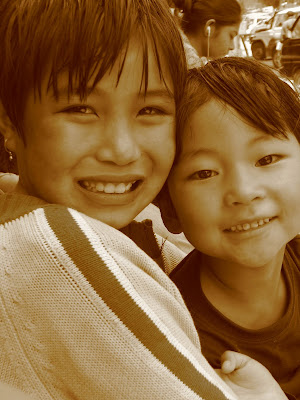 Sonam, with her elder sister
Sonam, with her elder sister Sonam, with her elder sister again
Sonam, with her elder sister again Sonam, with her recently acquired elder sister - these two were inseparable
Sonam, with her recently acquired elder sister - these two were inseparable Bhutan Happiness has an expectation, few people are unhappy in Bhutan
Bhutan Happiness has an expectation, few people are unhappy in Bhutan I was sitting around her - clicking pictures of the Dzong she just came and sat in my lap, as though I was her long lost 'papa', like me she's become a lonely planet fan at a very young age.
I was sitting around her - clicking pictures of the Dzong she just came and sat in my lap, as though I was her long lost 'papa', like me she's become a lonely planet fan at a very young age. Random kid we met at a Dhabba en route to Thimphu
Random kid we met at a Dhabba en route to Thimphu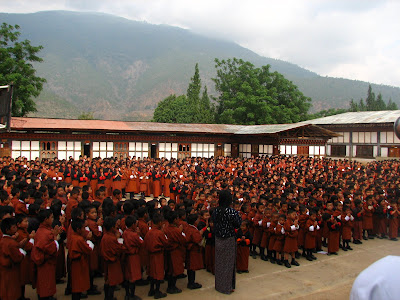 School Assembly at a little town called 'Wangdue'
School Assembly at a little town called 'Wangdue'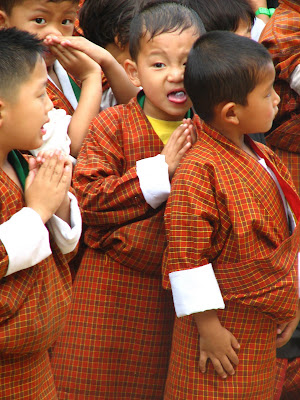 Just thought it made a cute picture
Just thought it made a cute picture And this one too
And this one tooEvery time we visited a Monastery we found ourselves discussing the same question. 'Are the Monks in Bhutan really happy or it is just that they do not know better?', since they joined monk hood when they were little kids. It did not help that the monks only spoke Dzongkha (Bhutanese local language) so we could never really get the truth from the horse's mouth.
They seemed happy to me, like all of Bhutan, content. I could not see myself being happy, were we to trade spots. Their life, in my opinion was downright depressing. Chant Buddhist prayers all day long and denounce almost all worldly possessions, except their mobile phones. Somehow, they were allowed to keep them and most of them had fancy phones with music players.
Because of the language barrier our interactions 'in terms of conversations were limited'. However, they were visibly excited and glad to have us around. They would surround us try and make us feel comfortable. Answer our questions to best of their ability using sign language or getting the monk who spoke a few lines in English or Hindi.
It was fun chilling with the monks. They are just a bunch of kids. Extremely humble and hospitable, they'd invite us to their rooms and serve us Bhutanese butter tea.
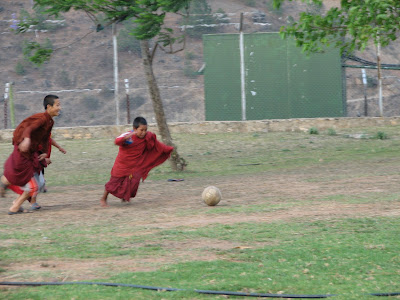 Monks at play
Monks at play
The most striking aspect of Bhutanese locals is their National dress. Apparently, Bhutan is the only country in world where men have a compulsory dress code. Men have to wear the 'Gyo' to school/college, place of worship, if they work at government office or enter a government office. Wearing the 'Gyo' and 'Kira' by women was more a norm than an exception. Rich kids in Thimphu seemed like the only section of people in Bhutan who were 'too cool' for the traditional dress. They would adorn western brands, but probably put in more effort into what they wore than an average Mumbai college kid.
Women in Bhutan looked really dainty in their Kira. With younger woman especially you could notice how meticulously matched their outfits were. On the other hand the 'Gyo' is more like a one piece dressing leaving no scope for creativity. except color and printed pattern.
We had numerous interactions with the locals. They are extremely affable with a very keen sense of pride in their culture, country and King.
Bhutan has had a century of very stable and peaceful monarchy. Everyone in Bhutan attributes their happiness and prosperity to their king, His Majesty, Jigme Singye Wangchuck. I was curious to know if a leader could be loved so unanimously. Judging from at least the fifteen people that I posed the question to 'do you love your kin?'. Their answer would always be a convincing 'yes' we love the king.
I spoke to Taxi-drivers, bus drivers, restaurant and pub owners and government officials. So my sample pool was not skewed to only one particular target audience. It hinted a sense of almost blind revered faith in the king. Almost like religion, if the king asked them to for instance jump of a bridge they probably would.
But in all honesty, the King is a benevolent dictator. He took over the throne at a very young age and lives a very inconspicuous life, a comfortable but not a very lavish palace in the hills. The policies of the nation, like 60% forest cover forever, or Gross Happiness Index, colleges imparting vocational skills are all his ideas. Bhutan in all aspects is an extremely far-sighted nation. I am a fan of the Bhutan king.
I loved the way Mothers in Bhutan will carry their kids around. Got a few pictures to illustrate my point.
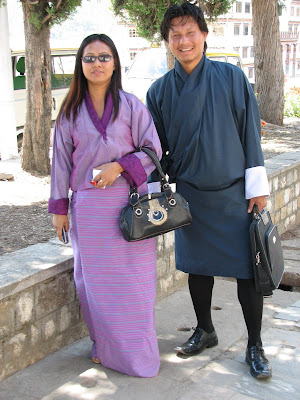 A couple, Presumably well to do
A couple, Presumably well to do Gyo and a Laptop, thought it was pretty cool
Gyo and a Laptop, thought it was pretty cool Such a convenient way to haul little kids
Such a convenient way to haul little kidsof everything made it increasingly difficult
to realize the strangeness of anything
- James Hilton, Lost Horizon
The paintings of 'much larger than in life' penises are literally all over Bhutan. But then its a strange country where the peculiarity just blends in rather than stand out.
The story in real short, goes Drukpa Kunley was a notorious lama who loved sleeping with different women, he loved drinking, but was blessed with divine powers. He was once given a strip of holy red rope which is usually tied around your wrist to bring you good luck. He decided to wear it around his penis so that it would bring him more luck with women. But having the painting on your house wall, apparently wards evil spirits away. They also have a temple of Drukpa Kunley, known as the temple of fertility where you can be blessed with a 14-inch wooden phallus (read: penis) and many a couples have then been able to procreate successfully.
Unraveling Bhutan was a blissful experience. When you go to Bhutan, your expected to visit a number of monasteries. We did indeed, but it was not the highlight of my trip. Not to take any credit away from some the most beautiful, peaceful and well maintained structures to me they were not as alive as 'Bhutan' on the streets was.
The following pictures will tell you how beautiful the monasteries are. Each one of them were imposing and stunning. We spent quite alot of time in each monastery, walking around exploring it, speaking to Monks. Tiger Nest was breath taking a great trek to approach it.
 Tiger Nest Monastery was breathtaking, featured on a few 'must visits before you die lists'
Tiger Nest Monastery was breathtaking, featured on a few 'must visits before you die lists' Tiger Nest, again on our way up to the Monastery
Tiger Nest, again on our way up to the Monastery Prayer Wheels
Prayer Wheels Everywhere
Everywhere The Prayer Wheels have a littler 'Prayer Inscribed', when you rotate them you send the the prayers into the sky :-)
The Prayer Wheels have a littler 'Prayer Inscribed', when you rotate them you send the the prayers into the sky :-)The closest to Utopia that this world will ever get. So little happens in the country, that they only need to print the newspaper twice a week and never more than ten pages.
A strange country, indeed.

